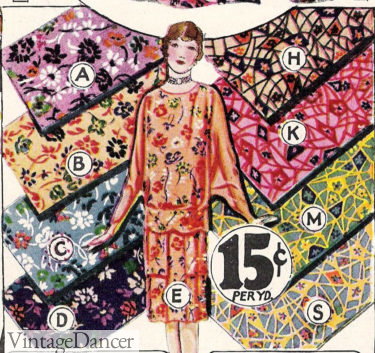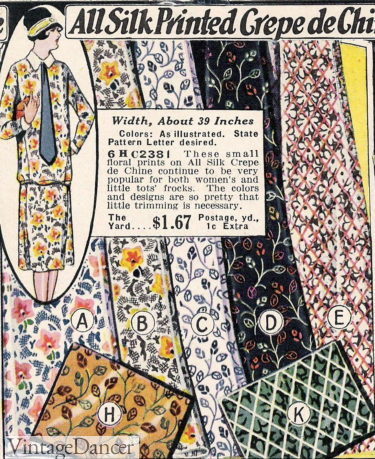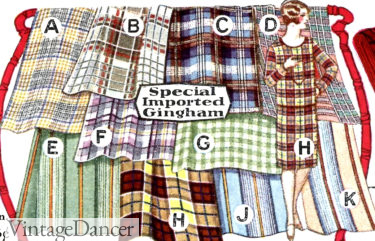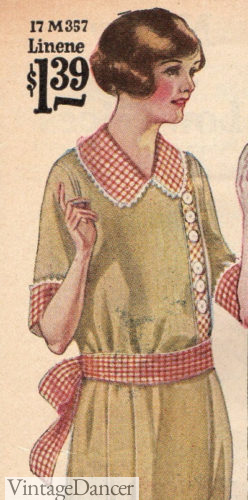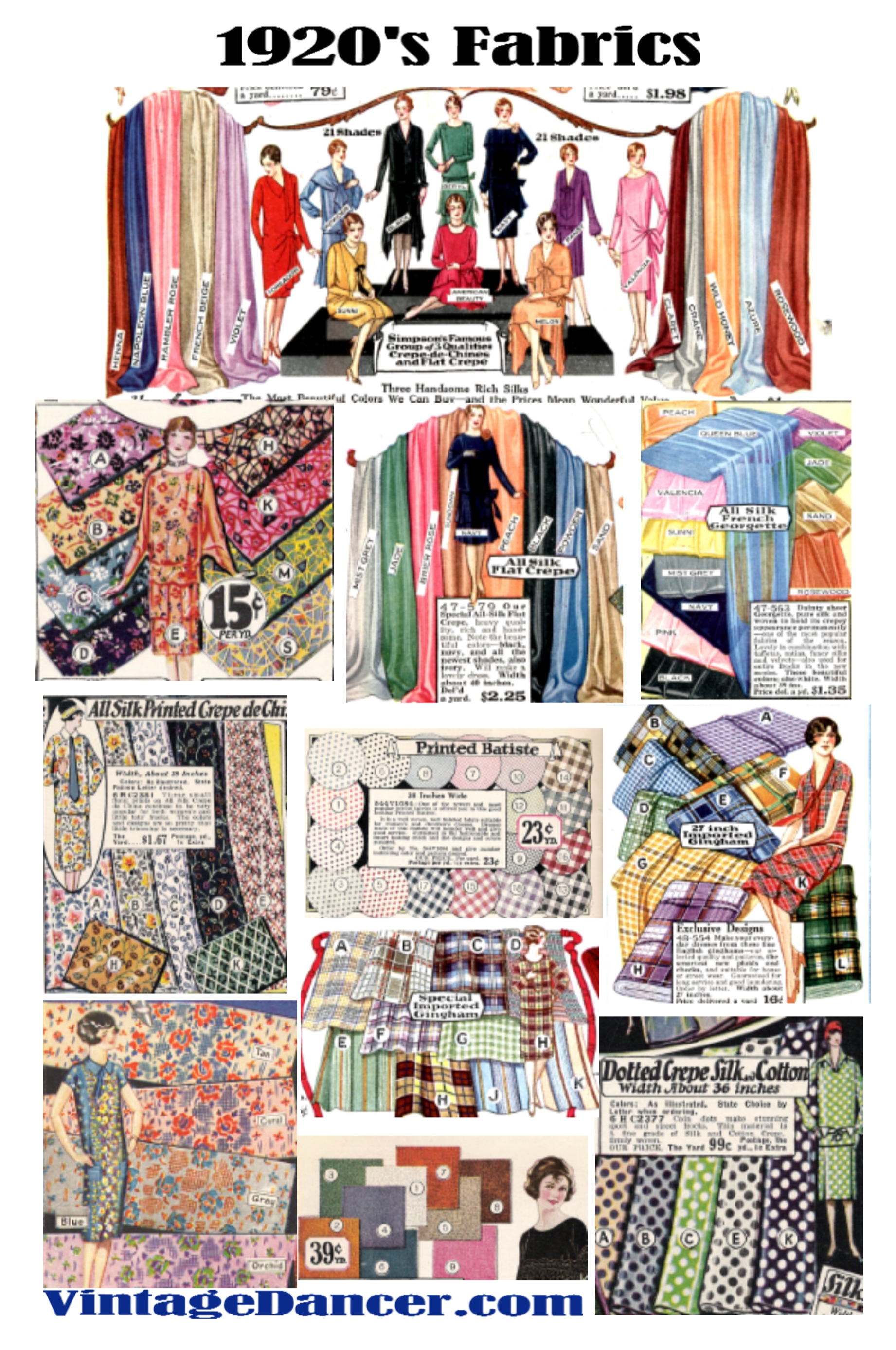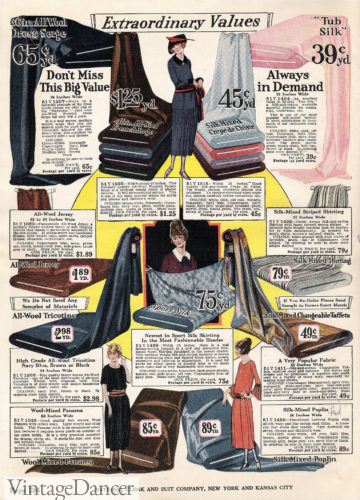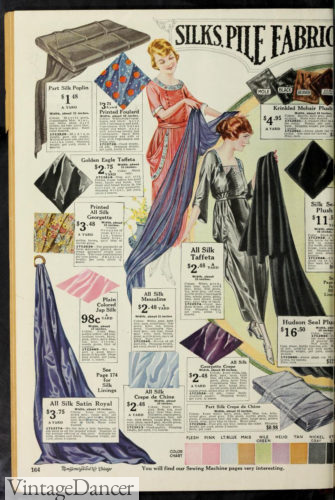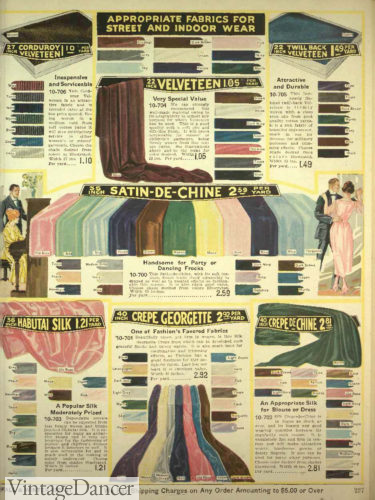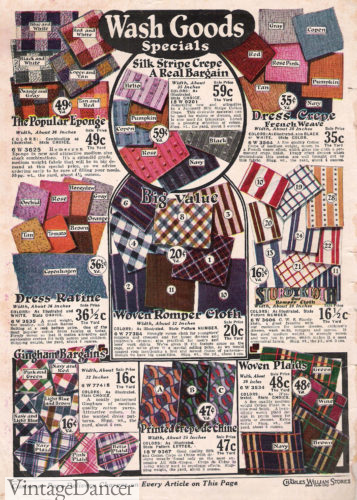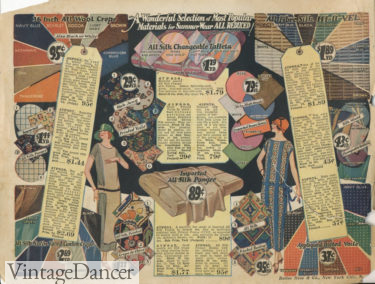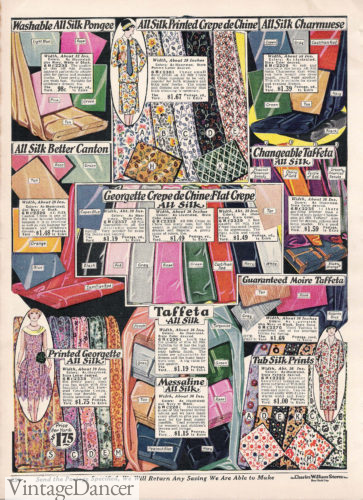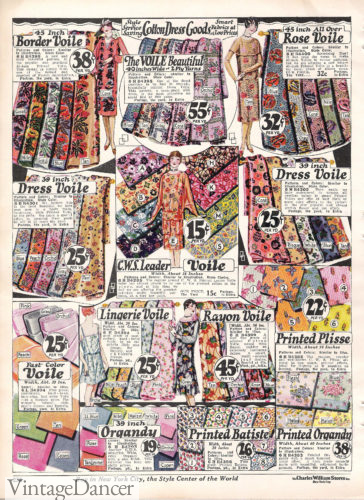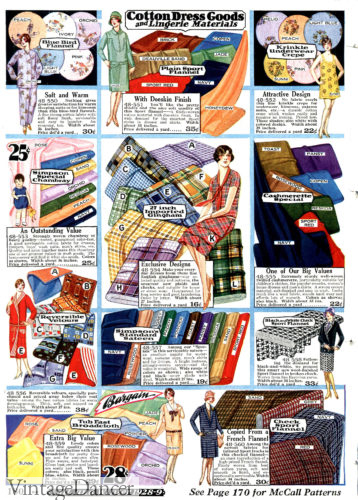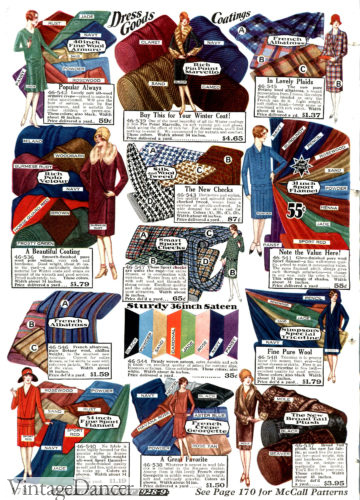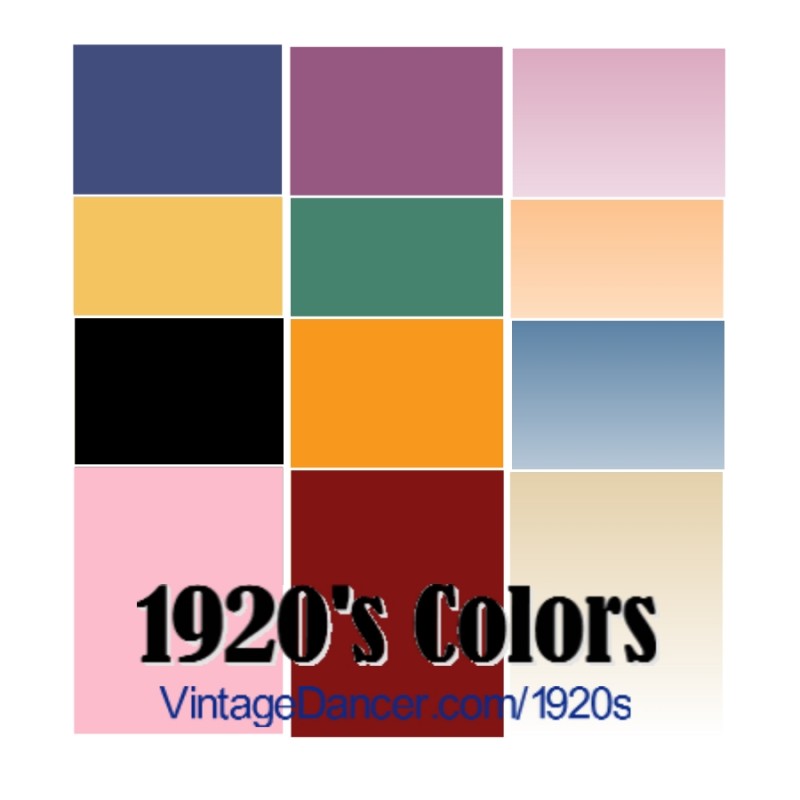
Common Clothing Colors of the 1920s
When I first picked up a vintage 1920s clothing catalog, I read the descriptions about dresses made of voile and stockings made of lisle. Huh? Voile? Lisle? These are not fabrics I read on my clothing tags.
Turning to the colors, I get even more confused. What is Gas blue? Palmetto green? French beige? Briar Rose? At least the men’s wear was a little more basic: wool, cotton or silk in brown, black, army green, grey, and navy blue.
Let us see if we can figure out what 1920s fabrics were made of, what they were used for, what colors they came in and how to shop for appropriate 1920s fabric today.
1920s Colors in Fashion
Solid colors were preferred over prints for most of the ’20s. A solid color showed off beads, embroidery, and ribbon decorations better than patterns. Early colors were mostly dark blue, tan, deep pink, burgundy, emerald green, and violet. Common prints were stripes, polka dots (yes!), repeating geometrics, large plaid, and simple florals. Patterns were used most often in skirts, children’s wear, house frocks, and lingerie. Everyone owned a plaid overcoat and every man had a plaid, check or stripe suit, dress shirt, and pajamas.
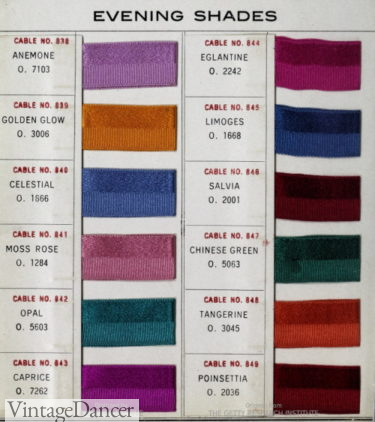
1922 evening fashion colors
Colors were overall of a muted or pastel palette. Colored included jade green, dusty peach, deep pink (called Rose), navy blue, medium blue, faded yellow, light grey, sand, burnt orange, buff, and violet (purple). Black was another fashionable color that was no longer strictly worn for mourning.
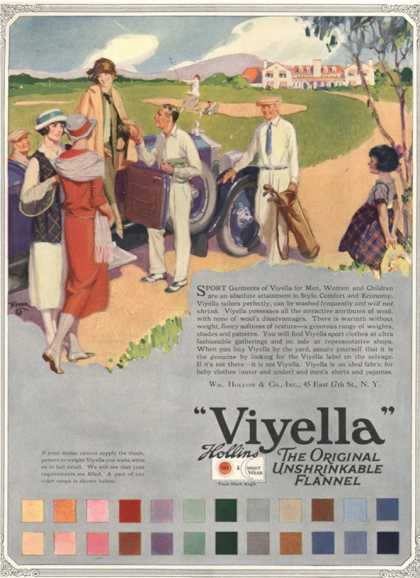
Spring fashion colors
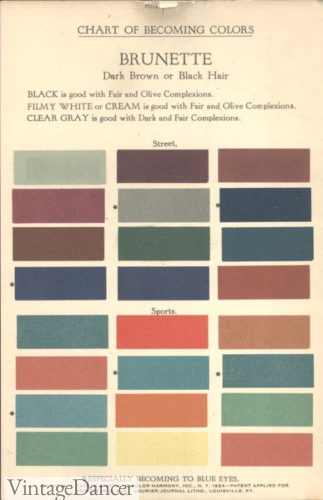
Fashion colors for brown hair
Prints encompassed all of the solid colors in some pretty opposite color combinations. Orange and blue. Blue and yellow. Grey and rose. Orange and black. Pink, purple and red. Green and violet.
- 1927 large florals
- 1927 florals
- 1928 plaid
1920s Fabrics
In general, 1920s fabrics were very delicate, thin, and airy for women, and stiffer but getting softer for the men. There was great care taken with ’20s clothing. Most garments were not washed as a whole, only spot cleaned as necessary to preserve the shape and colors. Dye ran easily, turning your brightly colored dress into a faded frock quickly. A few special dresses in my collection have never been washed in their lifetime!
Cotton- A growing industry in the 1920s was cotton mills. More and more clothing was made of durable, breathable cotton. During the chemical treatment called mercerizing, cotton took on the texture of silk, making it an affordable alternative to real silk. Mercerized cotton was especially popular with men’s dress shirts. Lisle was another very smooth cotton, slightly shiny, the thread used to make affordable stockings. Gingham cotton referred to the check print was very common as a house dress. Chambray cotton looks like a very light-weight blue denim. It was used for house dresses and sports clothes as well as men’s work shirts. Other cotton types: percale, cotton crepe, broadcloth (men’s dress shirts), flannel (men’s casual shirts and women’s nightclothes).
Cotton today is mostly crafter’s or quilter’s cotton – a stiff fabric that does not have the kind of drape 1920s garments need. As you shop for cotton (or a cotton blend) look for lightweight, very soft, draping cotton.
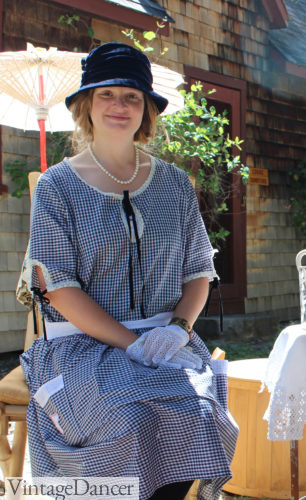
My 1920s gingham dress – Learn more about this outfit.
Voile was also made of cotton and it was soft and sheer. It could also be mixed with linen for a bit more shape. Voile was an excellent fabric for summer tea dresses. It is easily found today, but you will need to wear a slip underneath a dress because it is sheer.
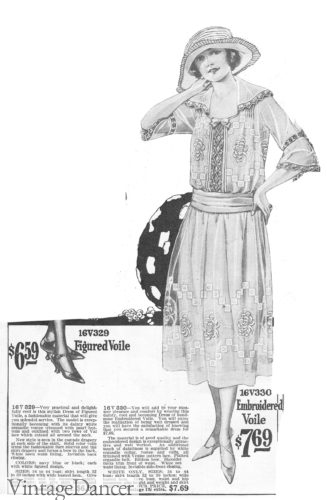
1922 white voile dresses, perfect for summer frocks
Wool – Wool came in two forms. Worsted wool was textured wool used to make tweeds, whipcords, and twill type materials most often used in outerwear and men’s clothing. Woolen is the other form. It is finished with a flat look and feel. It is more common in men’s suits, shirts, and ladies skirts and suits. Most wools were also mixed with cotton, flax, or silk to make finer and softer materials that were less prone to shrinking. Wool jersey was another very drapey but warm fabric used on winter dresses and sportswear. Coco Chanel claimed to have introduced jersey to the world of fashion.
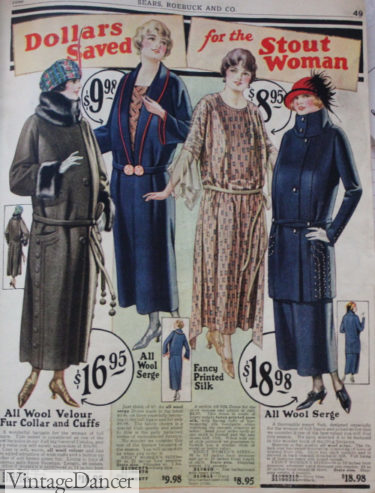
(L) Wool velour coat with fur (M) wool serge dress (L) wool serge suit
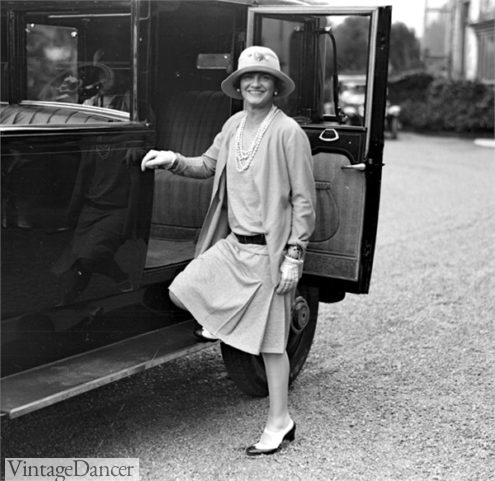
1928 Madame Coco Chanel, wearing a wool jersey suit
Silk – The cream of the crop in terms of quality. It was very labor intensive to make, so it was quite costly to buy. The fine silk thread weaved into a large assortment of different textures. Crepe was the roughest silk texture. Chiffon was very light and airy. Velvet was thicker, but not the incredibly thick velvet we see in fabric stores today. It was buttery soft with a brushed effect. Taffeta was a crisp, flat fabric with a shine to it. Organdy was a sheer but stiff fabric used in early ’20s party dresses. Most other silks were matte, very low shine materials. Many silks like Canton silk were blended with cotton for durability and price. Silk Pongee was used in men’s fine dress shirts. Lace was mostly out of fashion in the 1920s, but still used a trim. Lace made with new patterns of Art Deco inspired shapes was an attempt to entice women into wearing lace again.
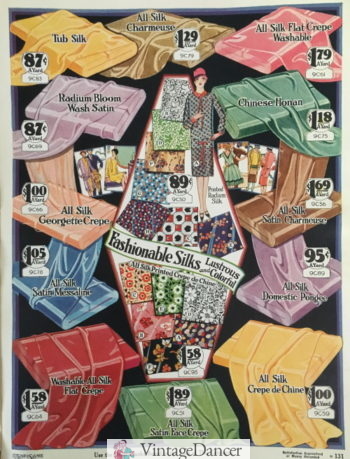
1928 silks dress colors
Georgette is sheer crepe silk, heavier than chiffon and with a crinkled surface. It was called “the material that both concealed and revealed” because it was see-through, but when embroidered or beaded it was modest enough for blouses and summer dresses (with a cami or slip underneath). It was used mostly on dress sleeves, necklines, upper backs, and overlays. It replaced lace from the previous decades as a fancy fabric.
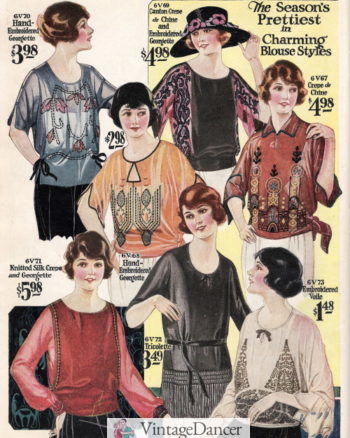
1922 silk crepe de chine and georgette embroidered blouses
Rayon – Known as the poor man’s silk, it is made of processed wood pulp. It was commonly called Artificial silk until almost the ’30s. At first, it was stiff and hard and not nice on the skin. It was blended with cotton to soften it up, and also mixed with wool for outerwear. Rayon improved enough by the end of the 1920s that is was used for delicate underwear, dresses, men’s shirts and ties, and even some men’s undergarments. Going into the 1930s, Rayon began replacing silk altogether. Today, rayon fabrics are wonderful to sew and drape well enough for most 1920s day and evening dresses.
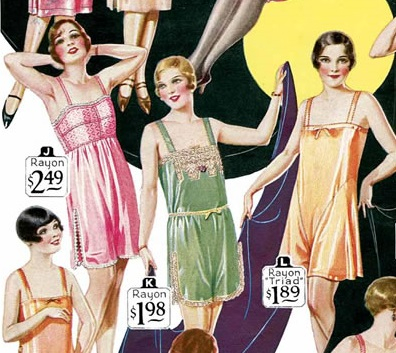
Cami knickers or all-in-ones with an open leg made of Rayon
Linen – A natural fiber used by the Egyptians that it is light, breathable, repels dirt, and wrinkles badly. It is mostly used for fine home “linens” and summer suits for men. Some undergarments were made of linen because it was very “hygienic.” Occasionally, women’s sport togs (knickers), skirts, and dresses, as well as house dresses, were made in linen. In the hottest climates (Florida, Australia, India, the French Riveria), linen clothes were more prevalent.
- Linen house dress with oversized peter pan collar
- Linen sailor dress
Knits – Knitted items were originally only associated with underwear or sports activities. The word “sport” appears frequently in advertisements where we would probably use the term “casual” today. The 1920s and its use of knitwear as high fashion propelled the home art of knitting. Women had knitting clubs and collected knitting magazines for the free patterns inside. Most knit clothes were sweaters, winter scarves and mittens, and shawls. In the late 1920s, machine-made knits as fabrics were turned into dresses, skirts, and suits suitable for any time of day. Sewing with knits is not for beginners, but you can create a lot of interesting Art Deco pattern clothes with them.
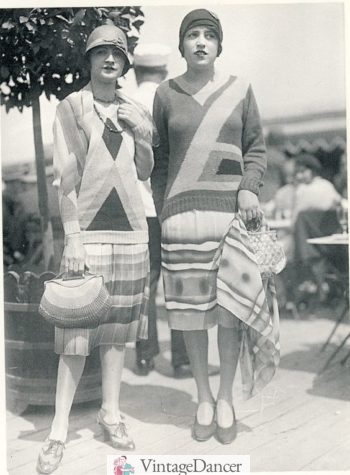
Colorblocking knit dresses
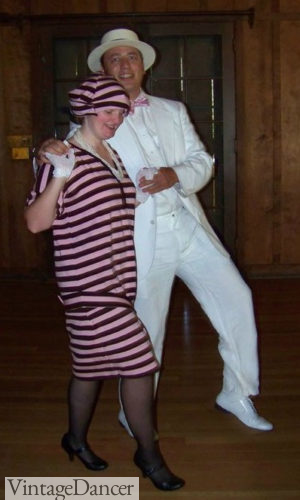
A sewed this early 20s dress and hat from a striped knit. Not my best handmade outfit but it was unique!
The downside to handmade knitwear of the early ’20s was that it was stiff. With minimal stretch to it, clothing hung straight. Ladies’ sweaters were pulled in with a knit belt to give some shape to the body. The stiffness of yarn worked very well for men’s knit ties. They actually held better shape than silk ties, which were prone to stretching out of place with just one wearing. Men’s socks, on the other hand, did not hold up with stiff yarn, so the use of socks garters was necessary. Improvements in the late ’20s made knitwear more useful for both men’s and women’s clothing.
1920s Fabric Swatches
- 1922 winter fabrics
- 1920 silks
- 1920 silks
- 1923 print day fabrics
- 1924 fashion fabrics
- 1927 solid dress fabrics
- 1927 print fabrics
- 1928 cottons
- 1928 dress and coat fabrics
1920s Men’s Suiting Fabrics
Men’s suiting fabric was not found in most catalogs. Suiting was sold for boys, which were often the same colors and patterns available for men. Most men’s clothing was tailor-made, not home-sewn. Women might sew a shirt or tie, but that was about it. See more examples.
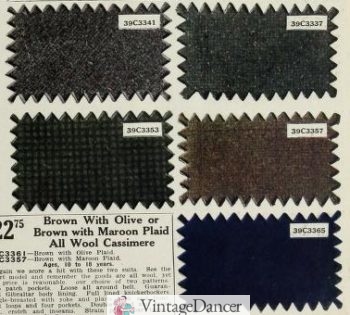
1920 suiting for boys
Where to shop for Fabrics
Here is a mega list of reproduction or new fabrics. Remember the most important part is drape (even if that means buying a polyester!). Need a sewing pattern? We have lists of those too- for women … and for men.
- Fabric.com – An assortment of basic fabrics. Sometimes I find great options here
- Fashion Fabrics Club – Modern fashion fabrics, some will work for vintage clothing
- Rick Rack – Authentic vintage cotton prints from the 1920s and beyond
- Donna Flower Vintage (UK) – Lovely authentic vintage fabrics
- Antique Fabric – Vintage 1920s fabrics
- Telalinda – 1920s-1940s reproduction fabrics
- Thai Silks – A huge assortment of silks and silk blends
- Damask Raven – Silks appropriate for historical clothing
- Renaissance Fabrics – Historical fabrics and trims
- Maltings Fabrics (UK) – Early 20th-century reproduction fabrics
- eBay – Vintage Sari Fabric, especially with a Deco print, is a great option for evening gowns, caftans and kimono coats
- Reproduction Fabrics – Mostly heavier cotton/crafting weight fabrics
- Spoon Flower – Vintage reproduction or inspired designs printed on a variety of fabrics
- Liberty Fabrics (UK) – Cotton and lawn printed fabrics. Also silk and linen
- Farm House Fabrics – Cotton, lawn, suiting, silk and more
- Sew La Di Da (UK) – vintage inspired cotton, linen, crepe, etc
- Til The Sun Goes Down (UK) – Vintage inspired designs from the 20s-60s
- B Back and Sons – Wool, cashmere and silk. Wool suiting ideal for menswear
- Dharma Trading – Dyeable silk, cotton, rayon and linen fabrics
- Burley and Trowbridge – Cotton, wool, silk and linen historical fabrics
- NY Fashion Center – Fashion fabrics, all kinds
- Mood Fabrics – Designer fashion fabrics, all kinds. Trims and leather too
- Fabric Mart Fabrics – Organized by fabric type
- IKEA – some amazing historical clothing has been made from Ikea’s fabric and curtains
- Farthingale – Corset, garter, petticoat making supplies and some fabric
- Croftmill (UK) Silk, wool, tweed, linen and more fashion fabric essentials
Debbie Sessions has been teaching fashion history and helping people dress for vintage themed events since 2009. She has turned a hobby into VintageDancer.com with hundreds of well researched articles and hand picked links to vintage inspired clothing online. She aims to make dressing accurately (or not) an affordable option for all. Oh, and she dances too.
